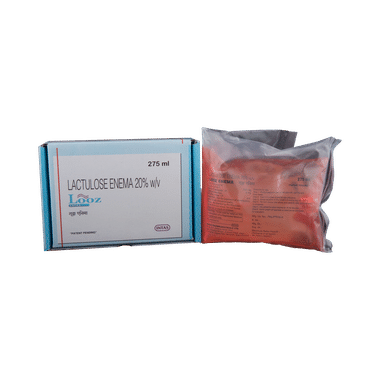

Lactulose (20% w/v)
Looz Enema is given as an enema in patients who are hospitalized or are unable to take it by mouth. The most common side effects are application site irritation, nausea, and vomiting. These are usually mild and go away after a couple of days. You may also feel (or be) sick. You can help avoid the side effects by drinking plenty of fluids, taking your medicine between meals. Occasionally people develop serious side effects including severe stomach pain, severe diarrhea, mood changes, and seizures. Talk to your doctor straight away if you notice any of these.Before taking this medicine, you should tell your doctor if you have diabetes or if you are unable to digest milk sugar (lactose intolerant). If you use this medicine over a long period of time, your doctor may want you to have occasional blood tests to check the mineral levels (e.g. potassium and sodium). Do not take other laxative medicines while taking this medicine and check with your doctor if you are pregnant or breastfeeding.
Most side effects do not require any medical attention and disappear as your body adjusts to the medicine. Consult your doctor if they persist or if you’re worried about themCommon side effects of Looz
275 ml Enema
Image shown is a representation and may slightly vary from the actual product. Every effort is made to maintain accuracy of all information displayed.
Your doctor or nurse will give you this medicine. Kindly do not self-administer.
Looz Enema works by drawing water into the intestine through osmosis, which makes the stool soft and easier to pass.
Related Warnings
No interaction found/established
Looz Enema is generally considered safe to use during pregnancy. Animal studies have shown low or no adverse effects to the developing baby; however, there are limited human studies.
Looz Enema is probably safe to use during breastfeeding. Limited human data suggests that the drug does not represent any significant risk to the baby.
No interaction found/established
Looz Enema is probably safe to use in patients with kidney disease. Limited data available suggests that dose adjustment of Looz Enema may not be needed in these patients. Please consult your doctor.
Looz Enema is probably safe to use in patients with liver disease. Limited data available suggests that dose adjustment of Looz Enema may not be needed in these patients. Please consult your doctor.
Looz Enema is used to treat constipation which is presented as infrequent bowel movements, hard and dry stools. It is also used in patients with hepatic encephalopathy which is a serious liver problem causing confusion, tremors and decreased level of consciousness.
Yes, Looz Enema is a laxative which softens the stools by pulling in water from the body to the large intestine. It is also used to reduce the amount of ammonia in the blood of patients with liver disease.
Looz Enema very commonly causes diarrhea, flatulence, nausea, vomiting and abdominal pain. Diarrhea and abdominal pain occur due to a high dose. In such cases, the dose should be reduced. Flatulence may occur during the first few days of treatment and may disappear after sometime. This medicine may also cause electrolyte imbalance. However, this is an uncommon side effect.
You should take Looz Enema for as long as advised by your doctor. You may also take it for as long as constipation lasts, which may be up to a week. For hepatic encephalopathy, the treatment may be longer, even several months.
Looz Enema should not be given to patients who are allergic to it or are intolerant to lactose (cannot process lactose). It should also be avoided in patients having galactosemia, a rare health problem where the body cannot process galactose.
Usually, one laxative is sufficient to relieve constipation. In case you need more, your doctor may advise you to take one more laxative along with Looz Enema. The risk of side effects is more with two laxatives.
Taking more than the recommended dose of Looz Enema may cause abdominal pain, electrolyte imbalance and diarrhea, which may last for a couple of days.